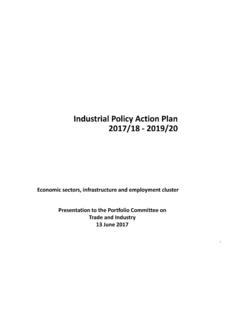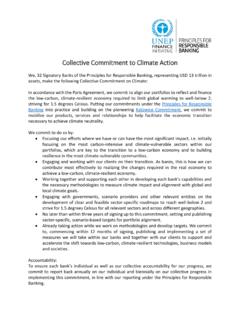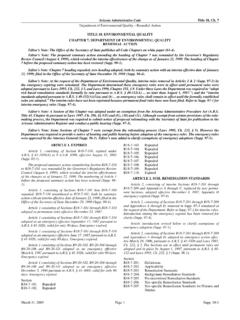Transcription of Public Narrative, Collective Action, - Marshall Ganz
1 18. Public narrative , Collective action , and Power Marshall Ganz The authors of this volume ask how discontented, but compliant, publics can mobilize to demand political change. It is not obvious. Organized Collective action to challenge the status quo, as opposed to the occasional outburst of resentment, does not "just happen." Nor does it occur as an automatic response to the availability of tools described elsewhere in this book citizen report cards, Public expenditure tracking, participatory budgeting, social audits, right-to-information acts, and so on. Nor does it arise as a result of a provi dential convergence of resources and opportunities, as often described by social movement theorists. Organized collectiveaction challenging the status quo a social movement . requires leadership that goes far beyond a stereotypical charismatic Public persona with whom it is often identified.
2 Unable to rely on established bureau cratic structures for coordination, evaluation, and action , such action depends on voluntary participation, shared commitments, and ongoing motivation. Movements must mobilize under risky conditions not only because well- resourced oppositions often resist their efforts,but also because the undertaking itself is fraught with uncertainty about how and whether it can happen in the first place. The capacity of a social movement for effectiveaction depends largely on the depth, breadth, and quality of leadership able to turn opportu nity to purpose. Mobilizing others to achieve purpose under conditions of uncertainty . what leaders do challenges the hands, the head, and the heart. As shown in figure ,the challengeof the "hands" is one of action , of learning, of adapt ing, and of mastering novelskills. The challengeof the head is one of strategy, 273.
3 274 Accountability through Public Opinion Figure Mobilization of Others strategy 0fe*PerienSce VAO>N Why Af* CTIV \. v0GO?- p*m6s shared understanding leads to action hands Source: Zac Willette and the author. imagining how to transform one's resources into the power needed to achieve one's purpose. The challenge of the heart is one of motivation, of urgent need to act, and of hope for success, and the courage to risk it. This is the work of Public narrative , the focus of this chapter. Public narrative is a leadership practice of translating values into action . It is based on the fact that values are experienced emotionally. As such, they are sources of ends worthy of action and the capacity for action . narrative is the discursive means we use to access values that equip us with the courage to make choices under conditions of uncertainty, to exercise agency. A story is constructed of a plot, character, and moral.
4 A plot is initiated by a challenge that confronts a character with a choice, which, in turn, yields an outcome. Because we identify empathetically with the character, wc experience the emo tional content of the moment the values in play,not simply the ideas. Narra tives thus become sources of learning, not only for the head, but also for the heart. Public narrative links the three elements of self, us, and now: why I am called, why we are called, and why we are called to act now. Far from new, this framework was articulated by the lst-century Jerusalem sage, Rabbi Hillel, who, in the Wisdom of theFathers, asks: If I am not for myself,who will be for me? If I am for myself alone, what am I? If not now, when?1. Two Ways of Knowing: Why and How Psychologist Jerome Bruncrargues that we interpret the world in two ways . the analytic and the narrative (Bruncr 1986). When we cognitivcly map the Public narrative , Collective action , and Power 275.
5 World, we identify patterns, discern connections, and hypothesize claims and test them the domain of analysis. But we also map the world affectivelyby coding experiences, objects, and symbols as good or bad for us, fearful or safe, hopeful or depressing, and so on. When we consider action in the faceof uncertainty, we haveto ask ourselves three questions: why must we act, how can we act, and what must we learn to do. Creative analytic thinking can help us answer the how question how do we use resources efficiently to detect opportunities, compare costs, and so on. We may need to learn new skills to answer the whatquestion. But to answer the why question why does it matter, why do we care, why must we risk action we turn to narrative . The why question is not simply why we think we oughtto act, but rather why we mustact, what moves us, our motivation, our values. Or, as St.
6 Augustine put it, we find ways of going beyond "knowing" the good as an ought to "loving the good" as a source of motivation. (St. Augustine 1991). Knowing Why: Emotion, Motivation, and action Because emotions are the medium through which we experience value, they provide us with vital information about the way we ought to live our lives as well as the motivation to live them in that way. To understand motivation . that which inspires action consider the word emotion and their shared root word motor, to move. Psychologists argue that the information provided by our emotions is partly physiological,as when our respiration changes or our body temperature alters; pardy cognitivebecause we can describe what we feel as fear, love, desire, or joy; and partly behavioral, as when we are moved to advance or to flee, to stand up or to sit down. So, as figure shows, our values are sources of the emotional information that can produce action .
7 Moral philosopher Martha Nussbaum argues that, because we experience values through our emotions, making moral choices in the absence of emo tional information is futile (Nussbaum 2001). She is supported by data about the experience of people afflicted with lesions on the amygdale, that part of the brain central to our emotions. When faced with decisions, people with this disability come up with one option after another, but they can never decide because decisions ultimately are based on values. If we cannot experience emotion, we cannot experience the values that orient us to our world. Thus, our readiness to deliberate, our capacity to deliberate successfully, and our ability to act on our decisions rest on how we feel. Mobilizing action Leadership requires understanding that while some emotions can inhibit mindful action , others can facilitate it. Explaining this relationship, political scientistGeorgeMarcus points to two neurophysiologic systems surveillance 276 Accountability through PublicOpinion Figure Values to action values emotion Source: Zac Willette and the author.
8 And disposition (Marcus 2002). Our surveillance system compares what we expect to see with what we do see, tracking anomalies that, when observed, spark anxiety. Without this emotional cue, we operate out of habit, on auto pilot. Anxiety is a way of saying to ourselves, "Hey! Pay attention! There's a bear in the doorway!". The big question is what we do about that anxiety (so we can figure out what to do about the bear). Our dispositional system operates along a contin uum from depressionto enthusiasm,or from despair to hope. If weexperience anxiety in a despairing mode, our fearwillkick in, producing withdrawal, rage, or freezing. However, hope inspirescuriosity, leading to exploration that can yield learning and creative problem solving. So our readiness to consider action , our capacity to consider it well,and our ability to act on our consider ation rest on how we feel.
9 Leaders engage others in purposeful action by mobilizing those feelings that facilitate action to trump feelings that inhibit action . Weoften hold con flicting feelings,some of which are more salient at one time than at another. At times, these feelings may have little to do with the present, but rather are a legacy of emotional lessons we learned longago. Suppose that, as a four-year- old child,you are playing on a swing set at a park when a bigger child tries to kickyou run to your parent for help,but your parent laughs it off. In that moment, you are angry and embarrassed, convinced that your parent does not learned counting on others is a bad idea. Now, as an adult, evaluating what to do about a paycut, this emotional lesson makes it unlikely that you will join other workers to protest. You fear counting on others; you mayeven tellyourself youdeserved that the grips Public narrative , Collective action , and Power 277.
10 Of that fear when an organizer comes along and tells you that, with a union, you could keep the employer from cutting your pay, you may see that orga nizer as a threat. Similarly, the value some people place on not upsetting the boss (teacher, parent, or employer) because of their dependency on that boss may conflict with the value they place on self-respect when the boss does something that violates their sense of self-respect. One person may become angry enough to challenge his or her boss; another may decide to "swallow their pride" or will resist the organizer who points out the conflict. Any resolu tion can be costly, but one may serve an individual's interests better than another. action Inhibitors and action Facilitators So the exercise of leadership often requires engaging people in an emotional dialogue, drawing on one set of emotions (or values) that are grounded in one set of experiences to counter another set of emotions (or values) that are grounded in different experiences a dialogue of the heart.




